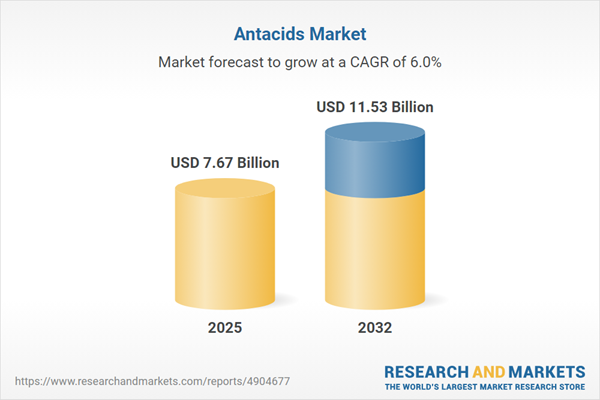Speak directly to the analyst to clarify any post sales queries you may have.
Leaders in the pharmaceutical and healthcare sectors face fast-evolving challenges and opportunities in the antacids market, driven by new consumer needs, regulatory updates, and technology. Staying informed is essential for guiding effective growth strategies in this shifting landscape.
Antacids Market Snapshot
The antacids market advanced from USD 7.24 billion in 2024 to USD 7.67 billion in 2025 and is projected to maintain a compound annual growth rate (CAGR) of 5.98%. Revenue projections forecast the market reaching USD 11.53 billion by 2032.
Scope & Segmentation
- Formulation Types: Covers effervescent tablets, gels, liquids, powders, and traditional tablet offerings, supporting a variety of preferences and use cases for symptomatic relief.
- Active Ingredients: Includes aluminum hydroxide, calcium carbonate, magnesium hydroxide, sodium bicarbonate, and various combination formulations, reflecting both longstanding and innovative antacid chemistries.
- Distribution Channels: Ranges from hospital pharmacy and retail pharmacy to online retail and supermarket/hypermarket platforms, addressing institutional and individual consumer demands and leveraging shifts toward e-commerce and omnichannel models.
- Regions: Encompasses Americas (including United States, Canada, Mexico, Brazil, Argentina, Chile, Colombia, Peru), Europe, Middle East & Africa (with United Kingdom, Germany, France, Russia, Italy, Spain, Netherlands, Sweden, Poland, Switzerland, UAE, Saudi Arabia, Qatar, Turkey, Israel, South Africa, Nigeria, Egypt, Kenya), and Asia-Pacific (comprising China, India, Japan, Australia, South Korea, Indonesia, Thailand, Malaysia, Singapore, Taiwan), highlighting varied regulatory, economic, and healthcare environments.
- Key Companies: Features leading manufacturers such as Haleon plc, Johnson & Johnson, Reckitt Benckiser Group plc, Sanofi SA, Bayer AG, Perrigo Company plc, Teva Pharmaceutical Industries Ltd, Viatris Inc., Dr. Reddy’s Laboratories Ltd, and SPI Pharma, each contributing to innovation and market presence.
Antacids Market: Key Takeaways for Decision-Makers
- The expansion of the antacids market is supported by growing rates of gastrointestinal disorders and an evident shift toward user-friendly, rapid symptom relief options, underscoring consumer emphasis on convenience.
- Advances in delivery mechanisms, such as effervescent products and gel-based formulations, cater to demand for quicker onset of action and improved adherence, while also enhancing product portfolios for differentiation.
- Lifestyle and wellness trends influence portfolio development, as sugar-free, clean-label, and targeted antacid solutions engage increasingly health-conscious buyers and diversify consumer segments.
- Supply chain adjustments become more critical in response to evolving regulations and tariffs, prompting manufacturers to diversify sourcing, partner with domestic or nearshore suppliers, and minimize supply disruptions.
- Digital health adoption is transforming distribution, direct-to-consumer strategies, and data-driven marketing, enabling highly personalized and responsive engagement with both prescribers and end-users.
- Strategic collaborations between pharmaceutical companies, research bodies, and contract manufacturers enable formulation innovation, integrated digestive health solutions, and accelerated market entry.
Tariff Impact: Navigating New Trade Measures
Recent tariff changes in the United States are impacting supply chain management, causing manufacturers to adapt ingredient sourcing and reconsider logistics to address increased costs in core components and packaging. As a result, companies are pursuing nearshoring, reinforcing relationships with local suppliers, and reassessing procurement to manage risk. These adjustments can influence pricing, margin strategies, and positioning within key markets, making agile decision-making and margin control even more important in maintaining competitiveness.
Methodology & Data Sources
This report is based on a comprehensive approach, combining primary interviews with executives, pharmacists, and procurement heads, together with extensive secondary analysis of company filings, regulatory updates, and trade data. Industry data are cross-validated by expert consultation to ensure accuracy, reliability, and actionable trend identification.
Why This Antacids Market Report Matters
- Provides actionable insights on segmentation, regional differences, and innovation, empowering strategic planning and resource allocation for senior leadership.
- Supports risk identification and mitigation through analysis of global supply chain challenges and regulatory changes, informing procurement and partnership strategies.
- Guides informed decisions for product development and investment by highlighting trends in consumer preference and the adoption of emerging digital technologies.
Conclusion
Comprehensive knowledge of the antacids market is crucial for decision-makers aiming to achieve sustainable growth and resilience. This report offers clarity and direction in a complex commercial environment, equipping leaders to act with confidence.
Additional Product Information:
- Purchase of this report includes 1 year online access with quarterly updates.
- This report can be updated on request. Please contact our Customer Experience team using the Ask a Question widget on our website.
Table of Contents
3. Executive Summary
4. Market Overview
7. Cumulative Impact of Artificial Intelligence 2025
List of Figures
Companies Mentioned
The key companies profiled in this Antacids market report include:- Haleon plc
- Johnson & Johnson
- Reckitt Benckiser Group plc
- Sanofi SA
- Bayer AG
- Perrigo Company plc
- Teva Pharmaceutical Industries Ltd
- Viatris Inc.
- Dr. Reddy’s Laboratories Ltd
- SPI Pharma
Table Information
| Report Attribute | Details |
|---|---|
| No. of Pages | 190 |
| Published | October 2025 |
| Forecast Period | 2025 - 2032 |
| Estimated Market Value ( USD | $ 7.67 Billion |
| Forecasted Market Value ( USD | $ 11.53 Billion |
| Compound Annual Growth Rate | 5.9% |
| Regions Covered | Global |
| No. of Companies Mentioned | 11 |









